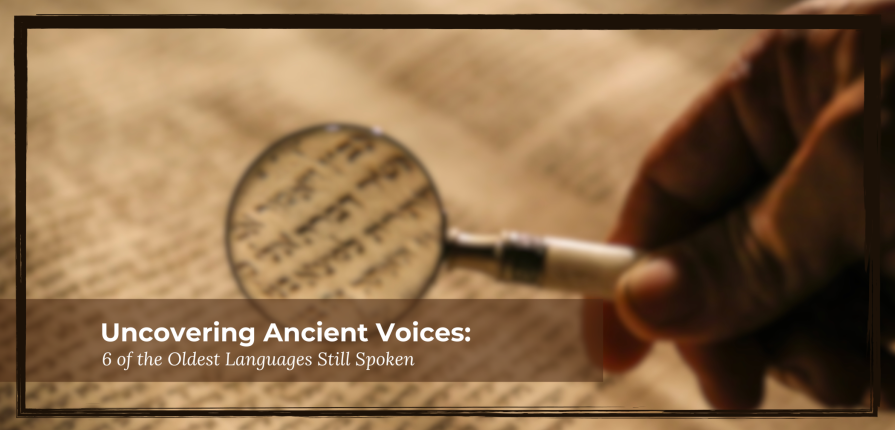What languages are the oldest still spoken in modern life? Let’s find out in the article VINALOCALIZE is bringing you today.
In today’s exploration of the world’s linguistic heritage, we will look into languages that have defied the test of time, echoing the voices of bygone civilizations. These ancient languages are like windows into the past, thus allowing us to glimpse the thoughts, stories, and wisdom of our predecessors.
As we embark on this journey to explore six of the oldest languages that continue to thrive in the present day, we’ll uncover the enduring legacies of human communication.
6 oldest languages in the world
(That are still spoken today)
Egyptian: A Timeless Script
The Egyptian language, encapsulated by its intricate hieroglyphic script, holds the distinction of being one of the world’s oldest known written languages. Rooted in the fertile Nile Valley, this linguistic marvel finds its origins dating back to approximately 3200 BCE. The hieroglyphs were a complex system of symbols and characters, frequently associated with the enchanting world of pharaohs and pyramids. In scholarly circles, Egyptian hieroglyphs reveal an extensive historical record encompassing literature, religious texts, as well as monumental inscriptions. This unique script acts as a bridge to the time of the pyramids, providing unparalleled insights into ancient Egyptian culture, society, and the echoes of their wisdom that persist today.
Sanskrit: The Classical Legacy
Sanskrit, a classical language of ancient India, emerged as a cornerstone of Indian culture and intellectual history. It boasts a lineage that extends beyond 2000 BCE, making it one of the earliest recorded languages in the world. Originally a sacred language of Hinduism, Sanskrit played a pivotal role in the development of India’s spiritual and philosophical traditions. The works of great sages, such as the Vedas and Upanishads, have been meticulously preserved in Sanskrit. Even though it is no longer a spoken language for daily conversation, Sanskrit remains alive as the language of sacred texts, philosophy, and classical Indian literature. Its legacy reverberates through India’s diverse linguistic landscape as well as the global study of ancient wisdom.
Greek: The Cradle of Civilization
Greek, renowned as the cradle of Western civilization, takes its place as one of the most influential languages in human history. Its roots trace back to the ancient Aegean world, with written records dating as far as 1400 BCE. The Greek language served as a conduit for extraordinary developments in philosophy, science, literature, and democratic governance. It was the tongue of Aristotle, Plato, Homer, and many other luminaries whose ideas continue to shape our modern world. While the Greece of antiquity has transformed, the Greek language still thrives, embedded in the culture and administration of contemporary Greece and Cyprus. Furthermore, it persists as a force transcending borders, connecting the ancient past with the present.
Chinese: An Ancient Language with Contemporary Relevance
The Chinese language, characterized by its intricate characters, has an extensive history that spans over 3,000 years. This makes it one of the oldest living languages in the world. Unlike alphabetic languages, Chinese characters are ideographic, where each character represents a word or concept. Beyond its longevity, Chinese is a vibrant, contemporary language, serving as the official language of China, Taiwan, and Singapore, with millions of native speakers as well as learners worldwide. It remains the key to unlocking China’s rich cultural heritage and accessing a dynamic, global economic powerhouse.

Aramaic: An Ancient Semitic Tongue
Aramaic, belonging to the Semitic language family, has a rich history dating back to the late 12th century BCE. It once served as the lingua franca of a vast region, from the Near East to the Levant. Aramaic is the language that resonates through some portions of the Hebrew Bible, most notably in the books of Daniel and Ezra. In addition, the language of Jesus Christ’s everyday life was Aramaic. Despite its ancient roots, Aramaic is still spoken by small, tight-knit communities in parts of the Middle East. It stands as a testament to linguistic endurance, offering a unique window into the ancient world that continues to live on.
Hebrew: The Sacred Tongue
Hebrew, an ancient Semitic language with roots in the second millennium BCE, holds a special place in the hearts of the Jewish people. It’s intrinsically tied to the holy scriptures of Judaism, especially the Torah, the foundation of Jewish law and religious practice. For centuries, Hebrew remained the preserve of liturgy and scholarship.
In the modern era, there has been a remarkable revival of spoken Hebrew, primarily in Israel. This revival transformed an ancient, almost dormant language into a dynamic, living one. The resurrection of Hebrew not only underscores its profound cultural significance but also showcases the remarkable resilience of ancient languages.
To sum it up…
The oldest languages still spoken today offer a profound bridge across the ages, linking past civilizations with contemporary times. Their enduring influence on culture, spirituality, and communication serves as a testament to the remarkable resilience of human linguistic heritage.
Want to discover more interesting language facts? Follow VINALOCALIZE and stay tuned for our updates!



